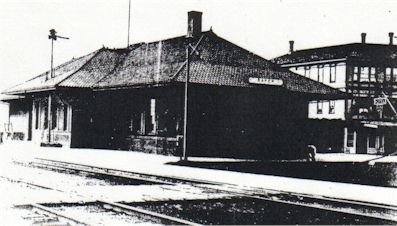Memories of Baker's UP Depot
By Phyllis Badgley

Baker's historic Union Pacific Depot at the west end
of Broadway was a sturdily built brick building. Red and green were
the predominating colors on the exterior. Inside, dark wainscoting
covered the lower portion of the lobby walls. The high ceiling and
slate floor together created space echoes, at least seemed that way
to me. I recall highly polished benches of light-colored wood; these
provided entertainment for a child who could playfully slide from
one end to the other. Brightly polished spittoons were placed around
the lobby. A Seth Thomas pendulum clock graced the wall.
I remember large iron-wheeled baggage carts with wooden tongues that
were pulled manually. They seemed to rumble as they crossed sidewalk
sections by the tracks.
The most prominent sound in the ticket office was the click click of
the telegraph machine. I recall Louis Heriza, the operator, sending
staccalo messages over the wire. In recent conversation with Mary
Heriza, she told me that her husband's railroad career spanned 45
years. He became station agent upon the retirement of Lynn
Vermillion. I remember Mr. Vermillion in a grey business suit, felt
hat, and wearing a heavy watch chain. Time pieces were of utmost
importance to the railroaders. Employees watches were mandated to be
checked every 6 months. W.E. Crawford and Maude Ellis were office
helpers. Maude, a friendly, soft spoken lady, sold me a ticket to
Canada in 1947. I was going as a delegate from the local Venture
Club, accompanied by Mary Jane Warner (Spence) and Doris Young (Leasy).
I recall the white stucco building to the south of the depot. It had
a large round sign painted on it that read "Railway Express Co."
Longtime Baker resident Charles Ellis was a faithful employee there
for 43 years.
Passenger trains came through Baker twice daily, and train numbers
were displayed in a lighted enclosure on the top of the engine. Even
numbers were Eastbound, occ numbers were Westbound. #17 going to La
Grande would whistle at the time it pulled into the station, our
family was there to meet it. We had hurriedly driven 7 blocks to
deposit a letter in the slide slot of the mail car. As the train
came to a halt, huge puffs of steam emitted from under the engine.
The engine usually stopped just short of the Church Street crossing,
unless it had to take on water; then it pulled forward to the water
tower.
I relished a brief talk with engineer Charlie Thompson (my uncle).
As he alighted from the cab he carried a long-spouted oil can which
could apply lubricant to wheel crossbars. His striped bill cap
matched his bib overalls, and a red kerchief protected his throat.
Noise from the huge iron horse made conversation difficult, but we
shouted a few words before he crawled up into the cab.
Near the base of the water tower was the "hobo" camp. Small bushy
trees marked the boundary. It was an eerie sight at night to see
darkened figures around the warming fire. My own feeling of safety
was assured when I was in company of my parents as we drove by in a
car.
In the mid-forties the taxis met each passenger train. My Dad, (Red
May) owned local "taxi eight0O" at that time. He insisted his
drivers be neatly groomed and open car doors for customers. During
those war years of gas rationing, taxis were granted extra gallonage.
Lush green lawn embraced both sides of the depot. Baker's good cold
water bubbled in the outside drinking fountain on the north. This
rock pedestal was about 4 feet high with a copper splash bowl. Some
of the rocks protruded enough to aid the climb of a thirsty child.
This fountain structure was identical to those found on Main St., in
front of the Geiser Hotel, Orpheum Theater, and Old Post Office.
A replica of a Conestoga wagon, emblematic of the Oregon Trail, was
placed on a lawn south of the depot. Complete with white canvas, it
proved an eye-catcher for passengers to view from the train cars.
Does any reader today know the whereabouts of that wagon? Or of the
whereabouts of the furnishings from the Union Pacific Depot?
A feeling of sadness consumed Baker residents upon seeing their
beloved depot in shambles. It met it's demise in the mid-seventies.
Railroad officials decided to erect a small glass enclosure that
would serve as the local depot. Most recently the former Sumpter
Valley Depot has been place by the tracks between Broadway and
Church streets, near where the old U.P. Depot was located.
Printed here with permission of Record Courier
